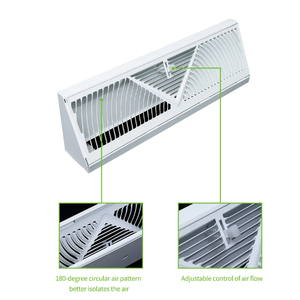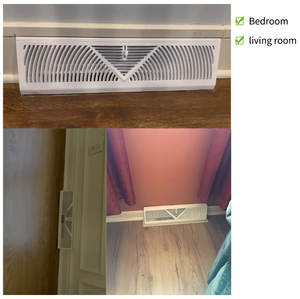
All categories
Featured selections
Trade Assurance
Buyer Central
Help Center
Get the app
Become a supplier

(183 products available)














































There are two main types of baseboard heating radiators, which are the electric ones and the hydronic baseboard heaters. These heating systems can be used as a primary or secondary heat source. They also have the same purpose as wall-mounted radiators, which is to warm a room in the home or commercial building. The only difference is that the baseboard heater is installed at the bottom of the wall, not mounted on the wall.
The electric baseboard heating system consists of a heating element, which is typically enclosed in a metal pipe, and a fan that blows hot air into the room. The element heats the air inside the unit when the thermostat calls for heat. This warm air rises, creating a convection current that circulates through the room. Electric baseboard heaters are typically used in areas where there is limited access to natural gas or other fuel sources. They are easy to install and require little maintenance. However, they can be more expensive to operate than other types of heating systems.
On the other hand, hydronic baseboard heaters work by using hot water that is heated in a boiler or a water heater. The warm water is pumped through a series of pipes that are connected to the heating element. The heat from the water is transferred to the air inside the unit, creating a convection current that warms the room. Hydronic baseboard heaters are more energy-efficient than electric models, but they require a boiler or water heater to operate.
Baseboard heating radiators can also be classified based on the material used to make them. They are available in different materials, including cast iron, steel, copper, and aluminum. Cast iron baseboard radiators are durable and can last for many years without damage. They are also good at retaining heat, but they take a while to heat up. Steel baseboard radiators are the most common type. They are lightweight and heat up quickly. Copper radiators are more expensive than other types, but they are efficient at transferring heat. Aluminum baseboard radiators are lightweight and easy to install. They are also the most affordable kind.
Buyers can also purchase the baseboard heating radiators in different styles. The most common is the standard type, which is a long, unobtrusive metal unit with a vented cover. There are also low-profile units that are shorter and less visible than the standard ones. The baseboard radiators can have a flat panel or a curved panel. Some have a decorative cover to hide the unit and enhance the room's appearance.
The function of a baseboard heater is to provide a steady heat source in a small, compact unit that can be mounted on the wall or hidden within a home's interior. The following are some features and functions of baseboard heating radiators:
Hot water baseboard heating systems offer the flexibility to control heat output to different parts of the house. Each room or zone can have its thermostat to set the preferred temperature. The heat output of baseboard heaters adjusts based on the thermostat setting and the actual temperature in that area.
Baseboard heating is compatible with various heat sources. It can work with boilers that use oil, gas, or electricity. Homeowners with existing forced air heating systems can use hydronic baseboard heaters to heat their homes. The heaters can also work with solar or geothermal heat sources to provide energy-efficient heating.
Hydronic baseboard heaters are slim and designed to be installed along the baseboards of a wall. They are usually several inches wide and less than a foot deep. The heaters are a popular option for homeowners who want to save space and avoid installing bulky heating equipment. The heaters are often installed in rooms where space is limited, such as bedrooms, bathrooms, and basements.
Hydronic baseboard heaters operate quietly. The hot water in the heater transfers heat through the copper or aluminum fins. The natural convection process warms the air next to the heater, causing the air to rise and circulate throughout the room. The heaters don't use fans or blowers, so there is no noise when the heater is running.
Hydronic baseboard heaters are energy-efficient. They heat rooms using hot water, which is an efficient way to transfer and retain heat. The natural convection process distributes the warm air throughout the room. The heaters don't lose heat through ductwork, making them more efficient than forced air systems. Homes with hydronic baseboard heaters use less energy for heating, reducing energy bills. The heaters also offer zone heating, which allows homeowners to heat only the rooms they are using.
Hydronic baseboard heaters are durable and have a long lifespan. The copper or aluminum fins are resistant to corrosion, even when exposed to moisture. The heaters have a simple design with no moving parts, so there is less chance of mechanical failure. Homeowners can expect the heaters to work well and last for many years with minimal maintenance.
Hydronic baseboard heaters require little maintenance. Homeowners should dust the heaters and vacuum the fins regularly to remove dirt and dust. The heater may make noise if the fins are too dusty. Inspect the heater for damage, such as bent fins, and replace the damaged parts. The heater will provide reliable heating with proper maintenance.
Hydronic baseboard heating systems are mainly used for home heating. They are versatile and can be used in various residential, commercial, and industrial applications. The following are some common applications of baseboard heating radiators:
Purchasers should consider various factors when selecting the right baseboard heater for their needs. These include the design of the radiator, the length of the radiator, and the BTU output of the radiator.
The design of the baseboard radiator is essential. Radiators with a sleek and compact design can fit in any room without taking up much space. They are available in different lengths and heights. These baseboard radiators are ideal for homes with limited wall space. The radiators have a modern style that blends well with the room decor. They have a powder-coated finish that prevents rusting.
hydronic heater. It has an energy-efficient design that homeowners prefer. The heater has a closed-loop system that uses water or steam to produce heat. It has copper tubing and aluminum fins that heat the room. This heater does not make noise or raise dust particles. It is a good option for people with allergies. The hydronic heater retains heat for a long time, even when the boiler shuts off.
Q1: What are the benefits of a baseboard heating radiator?
A1: Radiators are a cost-effective, energy-efficient way to heat homes. They provide consistent, comfortable warmth without the noise and drafts associated with forced-air systems. They are also relatively easy to install and require little maintenance.
Q2: How long do baseboard heating radiators last?
A2: With proper care, baseboard heating radiators can last for many years. Their simple design means they have fewer parts that can wear out, so they tend to have a long lifespan.
Q3: Can I add a baseboard heating radiator to a room?
A3: Yes, it is possible to add a baseboard heating radiator to a room as long as there is an available wall space along an exterior wall with access to the heating system. Also, the existing heating system must have the capacity to support the additional radiator.
Q4: What regular maintenance do baseboard heating radiators need?
A4: Baseboard heating radiators are relatively low maintenance. Periodically, they need to be bled to release any trapped air and maintain efficiency. Also, dusting the fins and keeping the area around them clean is important for optimal performance.